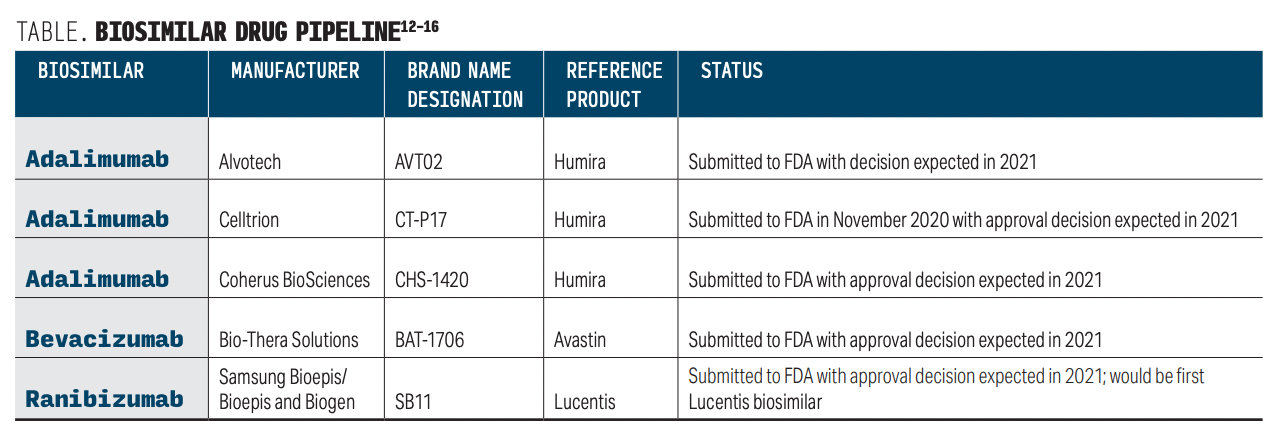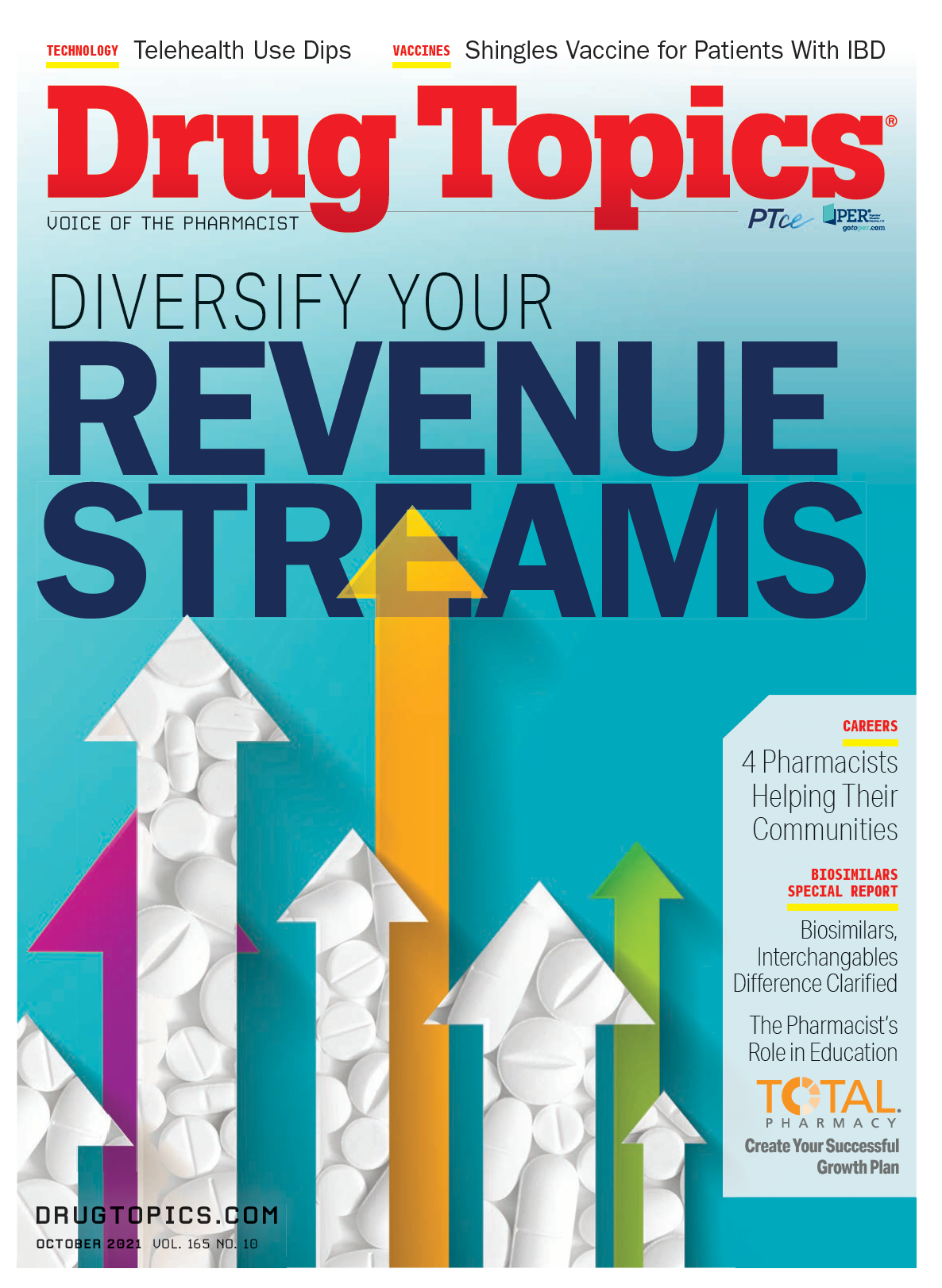Biosimilar Update and the Pharmacist’s Role in Education
Pharmacists can play an important role in managing patients on biosimilars and increasing uptake of these products.
The Biologics Price Competition and Innovation Act (BPCI Act) of 2009 created an abbreviated licensure pathway for biological products that are demonstrated to be interchangeable with an FDA approved biological product.1 Biosimilars provide patients with additional treatment options at lower costs.2 Typically, biosimilars marketed in the United States have initial list prices that are 15% to 35% lower than the existing FDA-approved biologic (reference product).2,3
Biosimilar products have no clinically meaningful differences from their reference product, and they undergo safety, ecacy, and quality evaluations.3 Pharmacists can play an important role in educating health care professionals and patients about biosimilars to improve access to and enhance their knowledge about these medications.
Biosimilar New Product Update
Semglee
As of August 21, 2021, the FDA approved 30 biosimilars, with the most recent being the first interchangeable biosimilar insulin product in the United States, Semglee (insulin glargine-yfgn).4,5
The reference product for Semglee is Lantus, a long-acting insulin. Semglee is approved for the treatment of type 1 diabetes in children and adults and for type 2 diabetes in adult patients.4 “This is a momentous day for people who rely daily on insulin for treatment of diabetes, as biosimilar and interchangeable biosimilar products have the potential to greatly reduce health care costs,” said FDA Acting Commissioner Janet Woodcock, MD, in a press release.4 This will help to make insulin more affordable for patients as the cost has skyrocketed.
Semglee is administered subcutaneously once daily at the same time each day.5 In patients with type 1 diabetes, Semglee must be used with short-acting insulin.5 The recommended starting dose in patients with type 2 diabetes who are not currently treated with insulin is 0.2 units/ kg or up to 10 units once daily.5 In patients switching from once-daily insulin glargine injection 300 units/mL to once-daily Semglee, the recommended initial dose is 80% of the insulin dose being discontinued.5
As with Lantus, the most common adverse effects reported with Semglee include hypoglycemia, edema, weight gain, allergic reactions, and injection site reactions.5
Riabni
Riabni (rituximab-arrx) received FDA approval in December 2020 as a biosimilar to Rituxan for the treatment of adult patients with non-Hodgkin lymphoma, chronic lymphocytic leukemia, granulomatosis with polyangiitis (inflammation of the blood vessels), and microscopic polyangiitis.6
Riabni is administered as an intravenous infusion by a health care professional.6 Prior to initiating treatment with Riabni, patients should be screened for hepatitis B infection.6 Riabni carries a boxed warning for fatal infusion-related reactions and it is critical to monitor patients closely as fatalities within 24 hours of infusion have occurred.6
Riabni infusions should be discontinued for severe reactions.6 Other boxed warnings include severe mucocutaneous reactions, hepatitis B virus reactivation, and progressive multifocal leukoencephalopathy.6
Hulio
The FDA approved Hulio (adalimumab-fkjp), the sixth biosimilar to Humira, in July 2020; it is expected to launch in July 2023 in the United States.7,8
Hulio is approved for the treatment of rheumatoid arthritis, juvenile idiopathic arthritis, psoriatic arthritis, ankylosing spondylitis, adult Crohn disease, ulcerative colitis, and plaque psoriasis.7 The agent is administered as a subcutaneous injection, and it carries a boxed warning for serious infections (eg, active tuberculosis [TB] and invasive fungal, bacterial, and viral infections) and malignancies (eg, lymphoma).7
Patients should be tested for TB prior to starting Hulio and monitored closely for any signs of infection during treatment.
Nyvepria
Nyvepria (pegfilgrastim-apgf) received FDA approval in June 2020 as a Biosimilar Update and the Pharmacist’s Role in Education Pharmacists can play an important role in managing patients on biosimilars and increasing uptake of these products.
It is a leukocyte growth factor indicated to decrease the incidence of infection in patients with nonmyeloid malignancies who are receiving myelosuppressive anticancer drugs associated with an increased incidence of febrile neutropenia.9 Nyvepria is administered as a subcutaneous injection. Serious adverse eects can include spleen rupture, acute respiratory distress syndrome (ARDS), serious allergic reactions, sickle cell crises in patients with sickle cell disorders, kidney injury, capillary leak syndrome, leukocytosis, malignancies, and inflammation of the aorta.9 Nyvepria should be discontinued in patients experiencing ARDS, serious allergic reactions, sickle cell crises, or inflammation of the aorta.9
Biosimilar Forecast and the Pharmacist’s Role in Education
According to an IQVIA report, biosimilar medications are expected to lower drug costs by $100 billion over the next 5 years.10 The development and approval of biosimilars has increased over the past 2 years.10 Since the passage of the BPCI Act, $17 billion in biosimilar spending has been associated with a savings of $37 billion.10 The following biosimilars launched in 2019 achieved significant uptake within their first year: bevacizumab (42%), trastuzumab (38%), and rituximab (20%).10
There are 108 biosimilars across 22 molecules in development, with some in the pipeline for the near future.

President Biden is working to improve access to biosimilar medications by promoting drug competition to drive down costs and facilitate the development and approval of biosimilar and interchangeable products.11
Pharmacists can assist in educating health care professionals and patients about biosimilars and the approval process to improve uptake. The FDA determines biosimilarity based on the “totality of evidence” provided in the marketing application submission.3 Animal, human pharmacologic, immunologic, and additional clinical data are added in a stepwise approach.3 Semglee being the first approved interchangeable biosimilar product provides further opportunities for education.4
An interchangeable biosimilar meets additional requirements and may be substituted for the reference product at the pharmacy, which can help increase patient access to these medications.3 The process is similar to the manner in which generic drugs are routinely substituted for brand products. For approval of an interchangeable biosimilar, manufacturers must provide additional data that reflect how the product can be used in clinical practice with patients.3
Studies generally evaluate the safety of patients’ alternating between the reference product and interchangeable biosimilar compared with those being treated with the reference product alone.3 Additionally, the results must reveal that there is no decrease in efficacy or increase in adverse effects with switching.3
Pharmacists can inform patients that biosimilars are safe and effective medications used to treat a variety of conditions, such as psoriasis, irritable bowel syndrome, Crohn disease, arthritis, kidney conditions, and cancer.3
The same benefits and adverse effects are expected with biosimilars compared with their original biologic product because they are made with the same types of natural resources and have the same strength and dosage recommendations. In addition, biosimilar medications can be used regardless of whether patients were first treated with the reference product. Emphasize to patients that biosimilars may provide them with more access to important treatments at lower costs.
Further, the FDA monitors the safety and effectiveness of all biosimilar medications after their approval.3 Explain that there are similarities and differences between biosimilars and generic drugs. For example, both are compared to a reference (original) product for approval,3 and both are versions of previously FDA-approved medications. Biosimilars and generics go through a thorough review process and receive FDA approval through different abbreviated pathways.3 One difference is that biosimilars are made from natural and living ingredients, whereas generics are generally made from chemical ingredients.3
As biologic medications cannot be replicated exactly, more information is required to show that a biologic is biosimilar to another biologic than that required for a generic drug.3
